On this article, we are going to stroll you thru the method of implementing high quality grained entry management for the information governance framework inside the Cloudera platform. This can permit an information workplace to implement entry insurance policies over metadata administration belongings like tags or classifications, enterprise glossaries, and information catalog entities, laying the inspiration for complete information entry management.
In an excellent information governance technique, you will need to outline roles that permit the enterprise to restrict the extent of entry that customers can need to their strategic information belongings. Historically we see three most important roles in an information governance workplace:
- Information steward: Defines the enterprise guidelines for information use based on company steering and information governance necessities.
- Information curator: Assigns and enforces information classification based on the foundations outlined by the information stewards in order that information belongings are searchable by the information shopper.
- Information shopper: Derives insights and worth from information belongings and is eager to grasp the standard and consistency of tags and phrases utilized to the information.
Inside the Cloudera platform, whether or not deployed on premises or utilizing any of the main public cloud suppliers, the Cloudera Shared Information Expertise (SDX) ensures consistency of all issues information safety and governance. SDX is a elementary a part of any deployment and depends on two key open supply initiatives to offer its information administration performance: Apache Atlas gives a scalable and extensible set of core governance companies, whereas Apache Ranger permits, displays, and manages complete safety for each information and metadata.
On this article we are going to clarify implement a high quality grained entry management technique utilizing Apache Ranger by creating safety insurance policies over the metadata administration belongings saved in Apache Atlas.
Case Introduction
On this article we are going to take the instance of an information governance workplace that wishes to manage entry to metadata objects within the firm’s central information repository. This permits the group to adjust to authorities laws and inside safety insurance policies. For this activity, the information governance crew began by wanting on the finance enterprise unit, defining roles and duties for various kinds of customers within the group.
On this instance, there are three completely different customers that may permit us to point out the completely different ranges of permissions that may be assigned to Apache Atlas objects by Apache Ranger insurance policies to implement an information governance technique with the Cloudera platform:
- admin is our information steward from the information governance workplace
- etl_user is our information curator from the finance crew
- joe_analyst is our information shopper from the finance crew
Word that it will be simply as straightforward to create extra roles and ranges of entry, if required. As you will note as we work by the instance, the framework offered by Apache Atlas and Apache Ranger is extraordinarily versatile and customizable.
First, a set of preliminary metadata objects are created by the information steward. These will permit the finance crew to seek for related belongings as a part of their day-to-day actions:
- Classifications (or “tags”) like “PII”, “SENSITIVE”, “EXPIRES_ON”, “DATA QUALITY” and so on.
- Glossaries and phrases created for the three most important enterprise items: “Finance,” “Insurance coverage,” and “Automotive.”
- A enterprise metadata assortment referred to as “Venture.”
NOTE: The creation of the enterprise metadata attributes will not be included within the weblog however the steps might be adopted right here.
Then, in an effort to management the entry to the information belongings associated to the finance enterprise unit, a set of insurance policies must be applied with the next situations:
The finance information curator <etl_user> ought to solely be allowed to:
- Create/learn classifications that begin with the phrase “finance.”
- Learn/replace entities which might be categorized with any tag that begins with the phrase “finance,” and likewise any entities associated to the “worldwidebank” challenge. The consumer must also have the ability to add labels and enterprise metadata to these entities.
- Add/replace/take away classifications of the entities with the earlier specs.
- Create/learn/replace the glossaries and glossary phrases associated to “finance.”
The finance information shopper <joe_analyst> ought to solely be allowed to:
- View and entry cClassifications associated to “finance” to look belongings.
- View and entry entities which might be categorized with tags associated to “finance.”
- View and entry the “finance” glossary.
Within the following part, the method for implementing these insurance policies shall be defined intimately.
Implementation of fine-grained entry controls (step-by-step)
So as to meet the enterprise wants outlined above, we are going to display how entry insurance policies in Apache Ranger might be configured to safe and management metadata belongings in Apache Atlas. For this objective we used a public AMI picture to arrange a Cloudera Information Platform setting with all SDX elements. The method of organising the setting is defined in this text.
1. Authorization for Classification Varieties
Classifications are a part of the core of Apache Atlas. They’re one of many mechanisms offered to assist organizations discover, manage, and share their understanding of the information belongings that drive enterprise processes. Crucially, classifications can “propagate” between entities based on lineage relationships between information belongings. See this web page for extra particulars on propagation.
1.1 Information Steward – admin consumer
To manage entry to classifications, our admin consumer, within the position of knowledge steward, should carry out the next steps:
- Entry the Ranger console.
- Entry Atlas repository to create and handle insurance policies.
- Create the suitable insurance policies for the information curator and the information shopper of the finance enterprise unit.
First, entry the Atlas Ranger insurance policies repository from the Ranger admin UI

Picture 1 – Ranger most important web page
Within the Atlas coverage repository:

Picture 2 – Atlas insurance policies
The very first thing you will note are the default Atlas insurance policies (word 1). Apache Ranger permits specification of entry insurance policies as each “permit” guidelines and “deny” guidelines. Nevertheless, it’s a advisable good follow in all safety contexts to use the “precept of least privilege”: i.e., deny entry by default, and solely permit entry on a selective foundation. It is a rather more safe method than permitting entry to everybody, and solely denying or excluding entry selectively. Due to this fact, as a primary step, you need to confirm that the default insurance policies don’t grant blanket entry to the customers we’re looking for to limit on this instance situation.
Then, you may create the brand new insurance policies (eg. take away the general public entry of the default insurance policies by making a deny coverage; word 2) and at last you will note that the newly created insurance policies will seem on the backside of the part (word 3).
After clicking the “Add New Coverage” button:
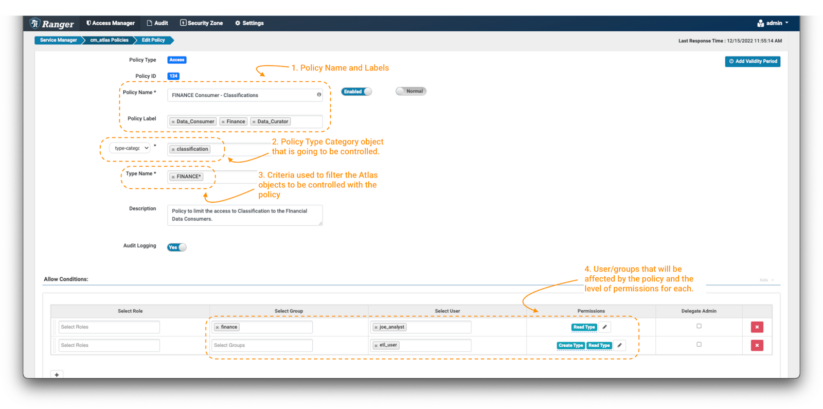
Picture 3 – Create coverage over finance classification
- First, outline a coverage title and, if desired, some coverage labels (word 1). These shouldn’t have a “useful” impact on the coverage, however are an necessary a part of holding your safety insurance policies manageable as your setting grows over time. It’s regular to undertake a naming conference in your insurance policies, which can embrace short-hand descriptions of the consumer teams and/or belongings to which the coverage applies, and a sign of its intent. On this case now we have chosen the coverage title “FINANCE Client – Classifications,” and used the labels “Finance.” “Information Governance,” and “Information Curator.”
- Subsequent, outline the kind of object on which you wish to apply the coverage. On this case we are going to choose “type-category” and fill with “Classifications” (word 2).
- Now, it’s essential outline the factors used to filter the Apache Atlas objects to be affected by the coverage. You need to use wildcard notations like “*”. To restrict the information shopper to solely seek for classifications beginning with the work finance, use FINANCE* (word 3).
- Lastly, it’s essential outline the permissions that you just wish to grant on the coverage and the teams and customers which might be going to be managed by the coverage. On this case, apply the Learn Sort permission to group: finance and consumer: joe_analyst and Create Sort & Learn Sort permission to consumer: etl_user. (word 4)
Now, as a result of they’ve the Create Sort permission for classifications matching FINANCE*, the information curator etl_user can create a brand new classification tag referred to as “FINANCE_WW” and apply this tag to different entities. This is able to be helpful if a tag-based entry coverage has been outlined elsewhere to offer entry to sure information belongings.
1.2 Information Curator – etl_user consumer
We are able to now display how the classification coverage is being enforced over etl_user. This consumer is just allowed to see classifications that begin with the phrase finance, however he can even create some extra ones for the completely different groups below that division.
etl_user can create a brand new classification tag referred to as FINANCE_WW below a guardian classification tag FINANCE_BU.
To create a classification in Atlas:
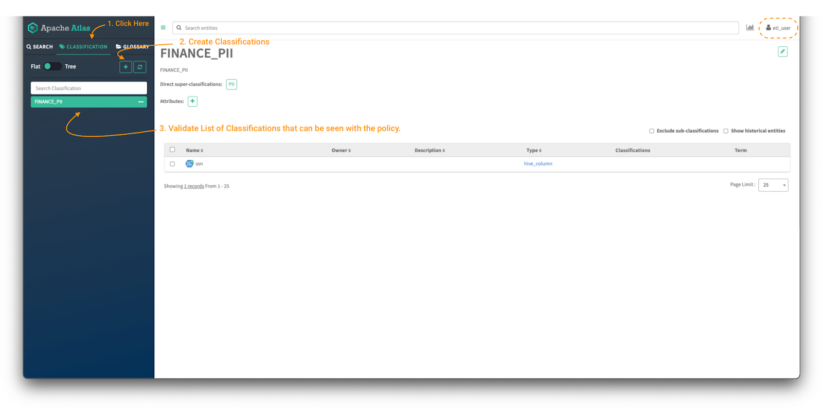
Picture 4 – Atlas classifications tab
- First, click on on the classification panel button (word 1) to have the ability to see the prevailing tags that the consumer has entry to. It is possible for you to to see the belongings which might be tagged with the chosen classification. (word 3)
- Then, click on on the “+” button to create a brand new classification. (word 2)
A brand new window open, requiring varied particulars to create the brand new classification.
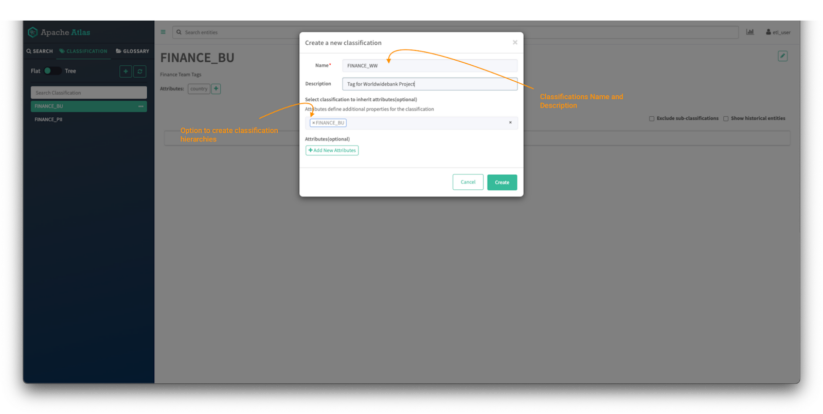
Picture 5 – Atlas classifications creation tab
- First, present the title of the classification, on this case FINANCE_WW, and supply an outline, in order that colleagues will perceive the way it must be used.
- Classifications can have hierarchies and people inherit attributes from the guardian classification. To create a hierarchy, sort the title of the guardian tag, on this case FINANCE_BU.
- Extra customized attributes will also be added to later be used on attribute-based entry management (ABAC) insurance policies. This falls outdoors of the scope of this weblog publish however a tutorial on the topic might be discovered right here.
- (Non-obligatory) For this instance, you may create an attribute referred to as “nation,” which is able to merely assist to prepare belongings. For comfort you can also make this attribute a “string” (a free textual content) sort, though in a dwell system you’d in all probability wish to outline an enumeration in order that customers’ inputs are restricted to a sound set of values.
After clicking the button “create” the newly created classification is proven within the panel:

Picture 6 – Atlas classifications tree
Now you may click on on the toggle button to see the tags in tree mode and it is possible for you to to see the guardian/little one relationship between each tags.
Click on on the classification to view all its particulars: guardian tags, attributes, and belongings presently tagged with the classification.
1.3 Information Client – joe_analyst consumer
The final step on the Classification authorization course of is to validate from the information shopper position that the controls are in place and the insurance policies are utilized accurately.
After efficiently logging in with consumer joe_analyst:
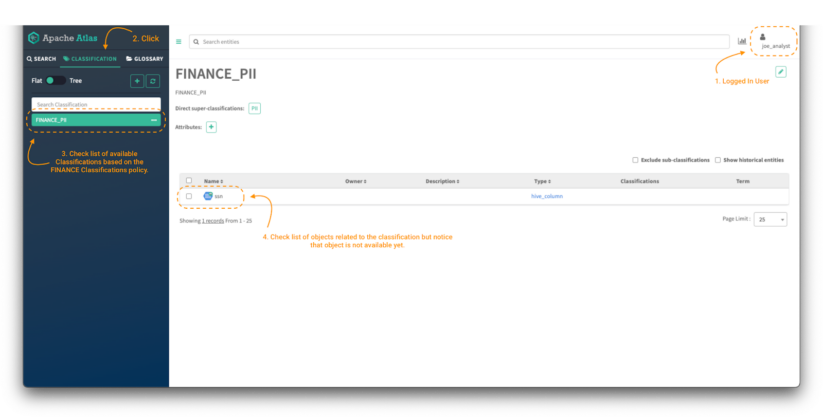
Picture 7 – Atlas classifications for finance information shopper
To validate that the coverage is utilized and that solely classifications beginning with the phrase FINANCE might be accessed based mostly on the extent of permissions outlined within the coverage, click on on the Classifications tab (word 2) and verify the record out there. (word 3)
Now, to have the ability to entry the content material of the entities (word 4), it’s required to present entry to the Atlas Entity Sort class and to the particular entities with the corresponding stage of permissions based mostly on our enterprise necessities. The following part will cowl simply that.
2. Authorization for Entity Varieties, Labels and Enterprise Metadata
On this part, we are going to clarify defend extra kinds of objects that exist in Atlas, that are necessary inside an information governance technique; specifically, entities, labels, and enterprise metadata.
Entities in Apache Atlas are a particular occasion of a “sort” of factor: they’re the core metadata object that characterize information belongings in your platform. For instance, think about you will have an information desk in your lakehouse, saved within the Iceberg desk format, referred to as “sales_q3.” This is able to be mirrored in Apache Atlas by an entity sort referred to as “ceberg desk,” and an entity named “sales_q3,” a selected occasion of that entity sort. There are a lot of entity sorts configured by default within the Cloudera platform, and you may outline new ones as nicely. Entry to entity sorts, and particular entities, might be managed by Ranger insurance policies.
Labels are phrases or phrases (strings of characters) that you may affiliate with an entity and reuse for different entities. They’re a lightweight method so as to add data to an entity so you’ll find it simply and share your data concerning the entity with others.
Enterprise metadata are units of associated key-value pairs, outlined prematurely by admin customers (for instance, information stewards). They’re so named as a result of they’re typically used to seize enterprise particulars that may assist manage, search, and handle metadata entities. For instance, a steward from the advertising and marketing division can outline a set of attributes for a marketing campaign, and add these attributes to related metadata objects. In distinction, technical particulars about information belongings are often captured extra straight as attributes on entity cases. These are created and up to date by processes that monitor information units within the information lakehouse or warehouse, and usually are not sometimes custom-made in a given Cloudera setting.
With that context defined, we are going to transfer on to setting insurance policies to manage who can add, replace, or take away varied metadata on entities. We are able to set fine-grained insurance policies individually for each labels and enterprise metadata, in addition to classifications. These insurance policies are outlined by the information steward, in an effort to management actions undertaken by information curators and shoppers.
2.1 Information Steward – admin consumer
First, it’s necessary to guarantee that the customers have entry to the entity sorts within the system. This can permit them to filter their search when in search of particular entities.
So as to take action, we have to create a coverage:
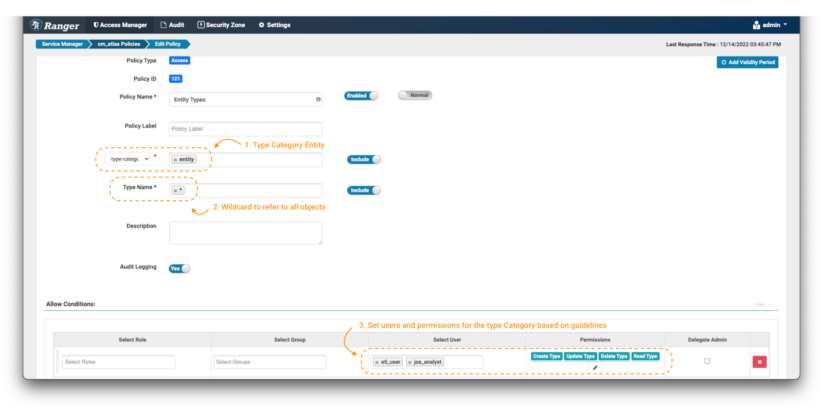
Picture 8 – Atlas entity sort insurance policies
Within the create coverage web page, outline the title and labels as described earlier than. Then, choose the type-category “entity”(word 1). Use the wildcard notation (*) (word 2) to indicate all entity sorts, and grant all out there permissions to etl_user and joe_analyst.(word 3)
This can allow these customers to see all of the entity sorts within the system.
The following step is to permit information shopper joe_analyst to solely have learn entry on the entities which have the finance classification tags. This can restrict the objects that he’ll have the ability to see on the platform.
To do that, we have to observe the identical course of to create insurance policies as proven within the earlier part, however with some modifications on the coverage particulars:
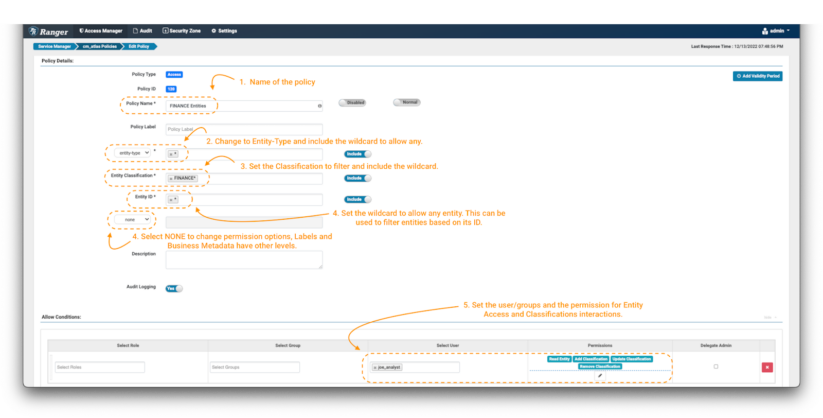
Picture 9 – Instance Atlas finance entity insurance policies
- As at all times, title (and label) the coverage to allow straightforward administration later.
- The primary necessary change is that the coverage is utilized on an “entity-type” and never in a “type-category.” Choose “entity-type” within the drop-down menu (word 2) and sort the wildcard to use it to all of the entity sorts.
- Some extra fields will seem within the type. Within the entity classification subject you may specify tags that exist on the entities you wish to management. In our case, we wish to solely permit objects which might be tagged with phrases that begin with “finance.” Use the expression FINANCE*. (word 3)
- Subsequent, filter the entities to be managed by the entity ID subject. On this train, we are going to use the wildcard (*) (word 4) and for the extra fields we are going to choose “none.” This button will replace the record of permissions that may be enforced within the situations panel. (word 4)
- As an information shopper, we wish the joe_analyst consumer to have the ability to see the entities. To implement this, choose the Learn Entity permission. (word 5)
- Add a brand new situation for the information curator etl_user however this time embrace permissions to change the tags appropriately, by including the Add Classification, Replace Classification & Take away Classification permissions to the particular consumer.
On this method, entry to particular entities might be managed utilizing extra metadata objects like classification tags. Atlas gives another metadata objects that can be utilized not solely to complement the entities registered within the platform, but in addition to implement a governance technique over these objects, controlling who can entry and modify them. That is the case for the labels and the enterprise metadata.
If you wish to implement some management over who can add or take away labels:
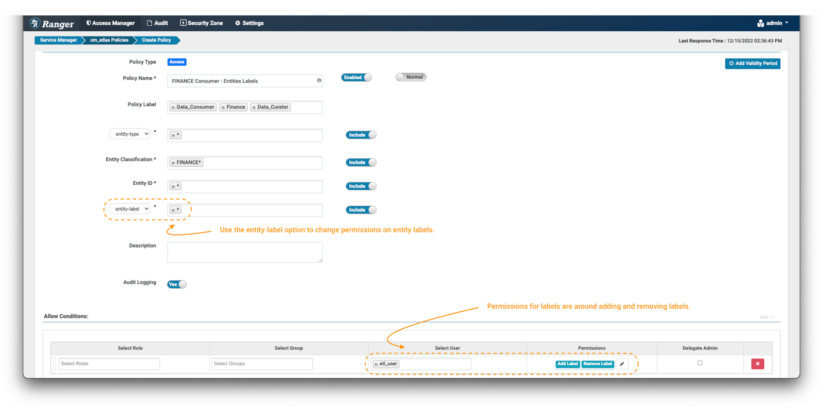
Picture 10 – Instance Atlas finance label coverage
- The one distinction between setting a coverage for labels versus the earlier examples is setting the extra fields filter to “entity-label” as proven within the picture and fill with the values of labels that wish to be managed. On this case, we use the wildcard (*) to allow operations on any label on entities tagged with FINANCE* classifications.
- When the entity-label is chosen from the drop-down, the permissions record shall be up to date. Choose Add Label & Take away Label permission to grant the information curator the choice so as to add and take away labels from entities.
The identical precept might be utilized to manage the permissions over enterprise metadata:

Picture 11 – Instance Atlas finance enterprise metadata coverage
- On this case, one should set the extra fields filter to “entity-business-metadata” as proven within the picture and fill with the values of enterprise metadata attributes that wish to be protected. On this instance, we use the wildcard (*) to allow operations on all enterprise metadata attributes on entities tagged with FINANCE* classifications.
- While you allow the entity-business-metadata drop-down, the permissions record shall be up to date. Choose Replace Enterprise Metadata permission to grant the information curator the choice to change the enterprise metadata attributes of economic entities.
As a part of the high quality grained entry management offered by Apache Ranger over Apache Atlas objects, one can create insurance policies that use an entity ID to specify the precise objects to be managed. Within the examples above now we have typically used the wildcard (*) to confer with “all entities;” under, we are going to present a extra focused use-case.
On this situation, we wish to create a coverage pertaining to information tables that are a part of a particular challenge, named “World Large Financial institution.” As a typical, the challenge house owners required that each one the tables are saved in a database referred to as “worldwidebank.”
To fulfill this requirement, we are able to use one of many entity sorts pre-configured in Cloudera’s distributions of Apache Atlas, specifically “hive_table”. For this entity sort, identifiers at all times start with the title of the database to which the desk belongs. We are able to leverage that, utilizing Ranger expressions to filter all of the entities that belong to the “World Large Financial institution” challenge.
To create a coverage to guard the worldwidebank entities:

Picture 12 – Instance Atlas Worldwide Financial institution entity coverage
- Create a brand new coverage, however this time don’t specify any entity classification, use the wildcard “*” expression.
- Within the entity ID subject use the expression: *worldwidebank*
- Within the Circumstances, choose the permissions Learn Entity, Replace Entity, Add Classification, Replace Classification & Take away Classification to the information curator etl_user to have the ability to see the small print of those entities and enrich/modify and tag them as wanted.
2.2 Information Curator – etl_user consumer
So as to permit finance information shopper joe_analyst to make use of and entry the worldwidebank challenge entities, the information curator etl_user should tag the entities with the permitted classifications and add the required labels and enterprise metadata attributes.
Login to Atlas and observe the method to tag the suitable entities:
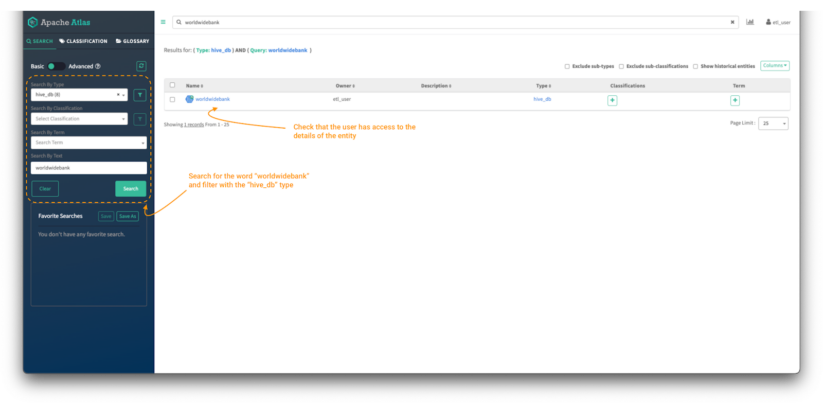
Picture 13 – Information curator entity search
- First, seek for the worldwidebank belongings utilizing the search bar. You too can use the “search by sort” filter on the left panel to restrict the search to the “hive_db” entity sort.
- As information curator, you need to have the ability to see the entity and be allowed to entry the small print of the worldwidebank database entity. It ought to have a clickable hyperlink to the entity object
- Click on on the entity object to see its particulars.
After clicking the entity title, the entity particulars web page is proven:
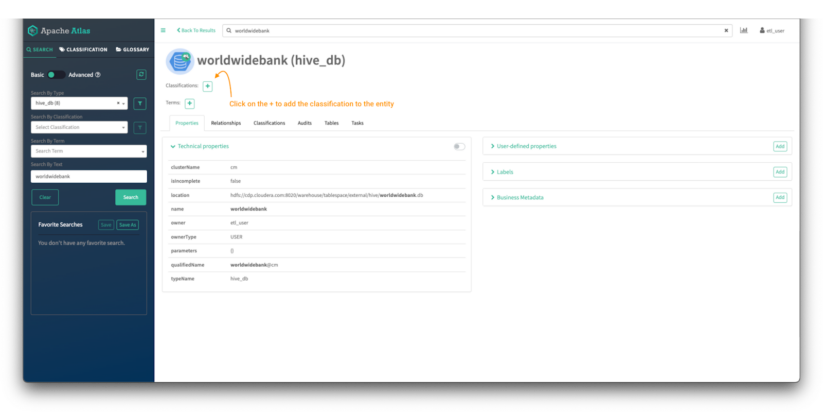
Picture 14 – Worldwide Financial institution database entity element
Within the high of the display screen, you may see the classifications assigned to the entity. On this case there aren’t any tags assigned. We are going to assign one by clicking on the “+” signal.
Within the “Add Classification” display screen:
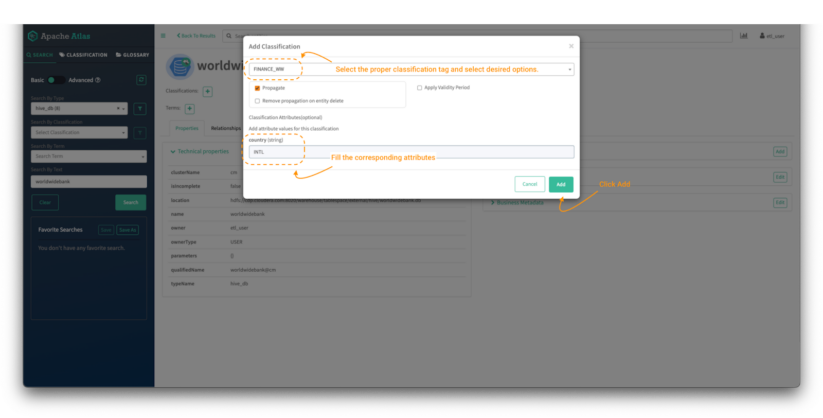
Picture 15 – Worldwide Financial institution database tag course of
- Seek for the FINANCE_WW tag and choose it.
- Then fill the suitable attributes if the classification tag has any. (Non-obligatory in Picture 5, within the 1.2 Information Curator – etl_user consumer part above.)
- Click on on “add.”
That can tag an entity with the chosen classification.
Now, enrich the worldwidebank hive_db entity with a brand new label and a brand new enterprise metadata attribute referred to as “Venture.”
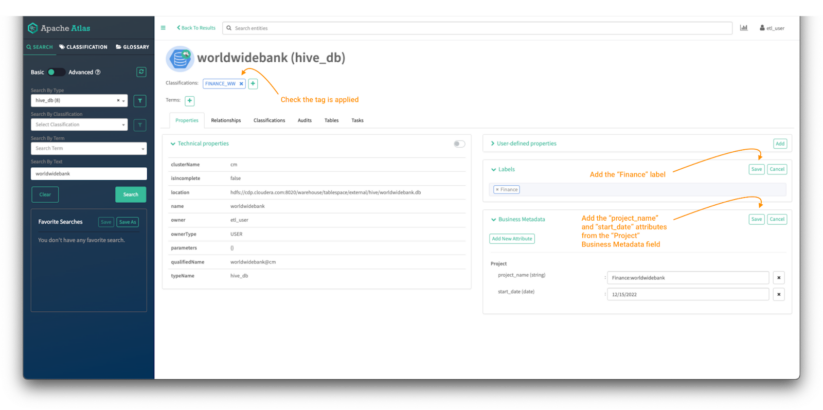
Picture 16 – Worldwide Financial institution database tag course of
Now, enrich the worldwidebank hive_db entity with a brand new label and a brand new enterprise metadata attribute referred to as “Venture.”
- So as to add a label, click on “Add” on the labels menu.
- Sort the label within the house and click on “save.”
- So as to add a enterprise metadata attribute, click on “Add” on the enterprise metadata menu.
- Click on on “Add New Attribute” if it’s not assigned or “edit” if it already exists.
- Choose the attribute you wish to add and fill the small print and hit “save.”
NOTE: The creation of the enterprise metadata attributes will not be included within the weblog however the steps might be adopted right here.
With the “worldwidebank” Hive object tagged with the “FINANCE_WW” classification, the information shopper ought to have the ability to have entry to it and see the small print. Additionally, you will need to validate that the information shopper additionally has entry to all the opposite entities tagged with any classification that begins with “finance.”
2.3 Information Client – joe_analyst consumer
To validate that the insurance policies are utilized accurately, login into Atlas:
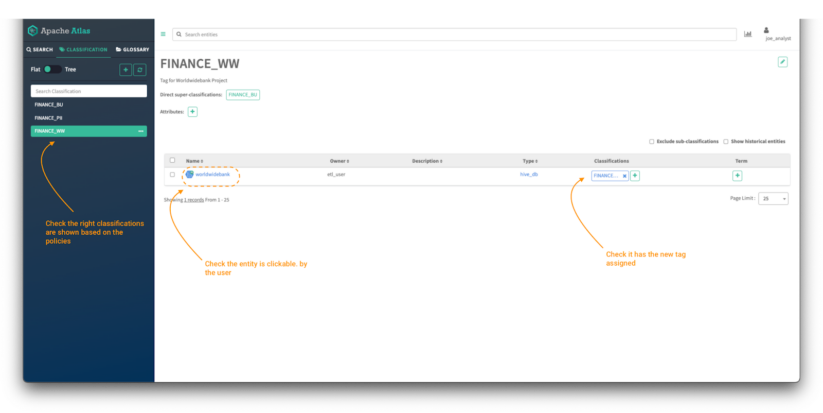
Picture 17 – Finance information belongings
Click on on the classifications tab and validate:
- The record of tags which might be seen based mostly on the insurance policies created within the earlier steps. All of the insurance policies should begin with the phrase “finance.”
- Click on on the FINANCE_WW tag and validate the entry to the “worldwidebank” hive_db object.
After clicking on the “worldwidebank” object:

Picture 18 – WorldWideBank database asset particulars
You possibly can see all the small print of the asset that the place enriched by the finance information curator in earlier steps:
- It’s best to see all of the technical properties of the asset.
- It’s best to have the ability to see the tags utilized to the asset
- It’s best to see the labels utilized to the asset.
- It’s best to see the enterprise metadata attributes assigned to the asset.
3. Authorization for Glossary and Glossary Phrases
On this part, we are going to clarify how an information steward can create insurance policies to permit fine-grained entry controls over glossaries and glossary phrases. This permits information stewards to manage who can entry, enrich or modify glossary phrases to guard the content material from unauthorized entry or errors.
A glossary gives applicable vocabularies for enterprise customers and it permits the phrases (phrases) to be associated to one another and categorized in order that they are often understood in numerous contexts. These phrases might be then utilized to entities like databases, tables, and columns. This helps summary the technical jargon related to the repositories and permits the consumer to find and work with information within the vocabulary that’s extra acquainted to them.
Glossaries and phrases will also be tagged with classifications. The advantage of that is that, when glossary phrases are utilized to entities, any classifications on the phrases are handed on to the entities as nicely. From an information governance course of perspective, which means that enterprise customers can enrich entities utilizing their very own terminology, as captured in glossary phrases, and that may routinely apply classifications as nicely, that are a extra “technical” mechanism, utilized in defining entry controls, as now we have seen.
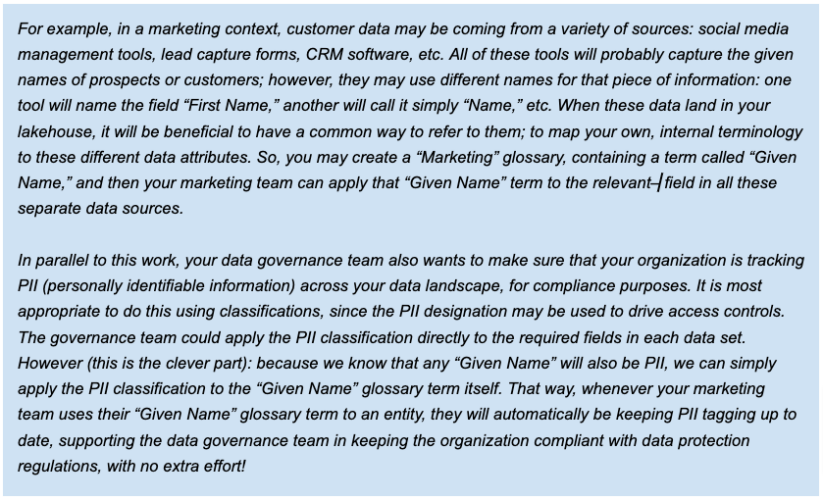
First, we are going to present how as an information steward you may create a coverage that grants learn entry to glossary objects with particular phrases within the title and validate that the information shopper is allowed to entry the particular content material.
3.1 Information Steward – admin consumer
To create a coverage to manage entry to glossaries and phrases, you may:
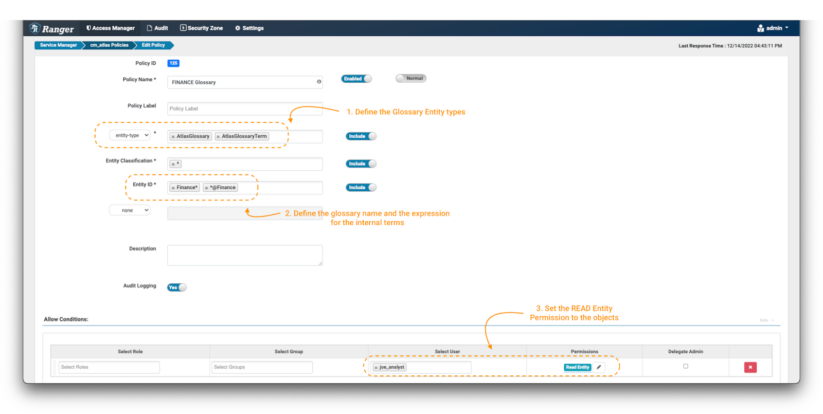
Picture 19 – Glossary management coverage
- Create a brand new coverage, however this time use the “entity-type” AtlasGlossary and AtlasGlossaryTerm. (word 1)
- Within the entity classifications subject, use the wildcard expression: *
- The entity ID is the place you may outline which glossaries and phrases you wish to defend. In Atlas, all of the phrases of a glossary embrace a reference to it with an “@” on the finish of its title (ex. time period@glossary). To guard the “Finance” glossary itself, use Finance*; and to guard is phrases, use *@Finance (word 2).
- Within the Circumstances, choose the permissions Learn Entity to the information shopper joe_analyst to have the ability to see the glossary and its phrases. (word 3)
3.2 Information Client – joe_analyst consumer
To validate that solely “Finance” glossary objects might be accessed:
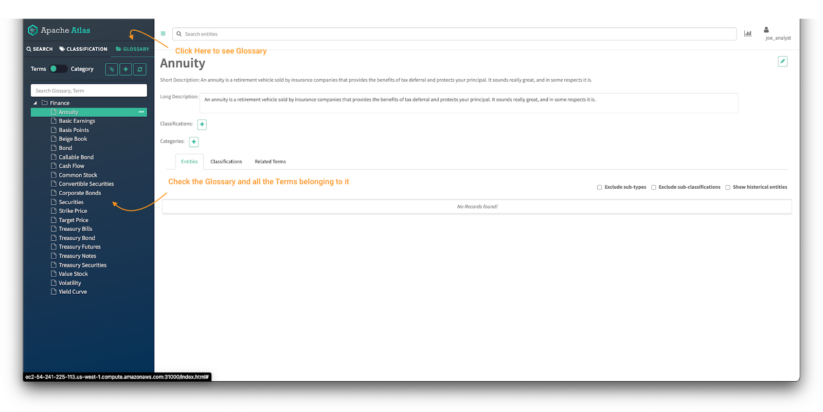
Picture 20 – Finance Atlas glossary
- Click on on the glossary tab within the Atlas panel.
- Examine the glossaries out there within the Atlas UI and the entry to the small print of the phrases of the glossary.
Conclusion
This text has proven how a corporation can implement a high quality grained entry management technique over the information governance elements of the Cloudera platform, leveraging each Apache Atlas and Apache Ranger, the elemental and integral elements of SDX. Though most organizations have a mature method to information entry, management of metadata is often much less nicely outlined, if thought-about in any respect. The insights and mechanisms shared on this article may help implement a extra full method to information in addition to metadata governance. The method is important within the context of a compliance technique the place information governance elements play a important position.
You possibly can be taught extra about SDX right here; or, we might like to hear from you to debate your particular information governance wants.

